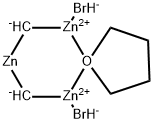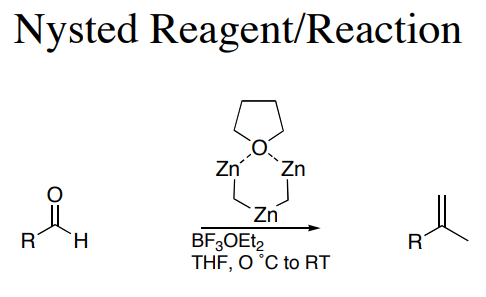
Nysted Reagent
- русский язык имя
- английское имяNysted Reagent
- CAS №41114-59-4
- CBNumberCB0352930
- ФормулаC6H12Br2OZn3
- мольный вес456.11
- номер MDLMFCD00134567
- файл Mol41114-59-4.mol
| плотность | 1.186 g/mL at 25 °C(lit.) |
| Fp | −15 °F |
| форма | slurry |
| ИнЧИКей | CCTHTLJWXPUNGT-UHFFFAOYSA-L |
| Справочник по базе данных CAS | 41114-59-4 |
| UNSPSC Code | 12352005 |
| NACRES | NA.22 |
| Коды опасности | F,Xn |
| Заявления о рисках | 11-14-19-22-36/37/38-40-36/37 |
| Заявления о безопасности | 16-26-36-36/37 |
| РИДАДР | UN 3399 4.3/PG 2 |
| WGK Германия | 3 |
рисовальное письмо(GHS)
-
рисовальное письмо(GHS)



-
сигнальный язык
опасность
-
вредная бумага
H319:При попадании в глаза вызывает выраженное раздражение.
H335:Может вызывать раздражение верхних дыхательных путей.
H351:Предполагается, что данное вещество вызывает раковые заболевания.
H225:Легковоспламеняющаяся жидкость. Пары образуют с воздухом взрывоопасные смеси.
H336:Может вызывать сонливость или головокружение.
-
оператор предупредительных мер
P201:Беречь от тепла, горячих поверхностей, искр, открытого огня и других источников воспламенения. Не курить.
P202:Перед использованием ознакомиться с инструкциями по технике безопасности.
P210:Беречь от тепла, горячих поверхностей, искр, открытого огня и других источников воспламенения. Не курить.
P233:Держать в плотно закрытой/герметичной таре.
P305+P351+P338:ПРИ ПОПАДАНИИ В ГЛАЗА: Осторожно промыть глаза водой в течение нескольких минут. Снять контактные линзы, если Вы ими пользуетесь и если это легко сделать. Продолжить промывание глаз.
P308+P313:ПРИ подозрении на возможность воздействия обратиться за медицинской помощью.
Nysted Reagent химические свойства, назначение, производство
Химические свойства
The Nysted reagent is a reagent used in organic synthesis for the methenylation of a carbonyl group. It was discovered in 1975 by Leonard N. Nysted in Chicago, Illinois. It was originally prepared by reacting dibromomethane and activated zinc in THF.A similar reagent is Tebbe's reagent.In the Nysted olefination, the Nysted reagent reacts with TiCl to methylenate a carbonyl group. The biggest problem with these reagents are that the reactivity has not been well documented. It is believed that the TiCl acts as a mediator in the reaction. Nysted reagent can methylenate different carbonyl groups in the presence of different mediators. For example, in the presence of BF•OEt, the reagent will methylenate aldehydes. On the other hand, in the presence of TiCl, TiCl or TiCl and BF•OEt, the reagent can methylenate ketones. Most commonly, it is used to methylenate ketones because of their general difficulty to methylenate due to crowding around the carbonyl group. The Nysted reagent is able to overcome the additional steric hinderance found in ketones, and more easily methylenate the carbonyl group.
There is little research on Nysted reagent because of the hazards and high reactivity and the difficulty of keeping the reagent stable while it is in use. More specifically, it can form explosive peroxides when exposed to air and is extremely flammable. Also, it reacts violently with water. These make this reagent very dangerous to work with.
Использование
The cyclo-dibromo-di-m-methylene-(m-tetrahydrofuran)-trizinc is known as the Nysted reagent. This reagent is prepared by treatment of dibromomethane with activated zinc-lead couple or hydrogen chloride-activated zinc dust in THF. This reagent is useful for converting a carbonyl group into a methylene group, and such transformation is known as the Nysted methylenation or Nysted olefination. The study finds that this reagent is superior to the Tebbe reagent.прикладной
Useful reagent for the methylenation of ketones and α-ketols.Reactant for:
Synthesis of amphidinolide T3 using a ring-closing metathesis and asymmetric dihydroxylation strategy
Methylenation of carbonyl compounds
Olefination reactions
Реакции

This commerically available reagent is capable of methyenylation alone or in concert with TiCl4. While information on the reactivity of the reagent exists, the mechanistic basis of its function has yet to be elucidated.
Nysted Reagent запасные части и сырье
Nysted Reagent поставщик
| поставщик | телефон | страна | номенклатура продукции | благоприятные условия |
|---|---|---|---|---|
| +86-(0)57185586718 +86-13336195806 |
China | 29792 | 60 | |
| +86-0371-86658258 +8613203830695 |
China | 29871 | 58 | |
| 86-13657291602 | CHINA | 22963 | 58 | |
| +86-023-6139-8061 +86-86-13650506873 |
China | 39894 | 58 | |
| +86-13806087780 | China | 17365 | 58 | |
| +86-0551-65418671 +8618949823763 |
China | 34563 | 58 | |
| +8615255079626 | China | 23541 | 58 | |
| +86-029-89586680 +86-18192503167 |
China | 7724 | 58 | |
| +86-0571-85134551 | China | 15352 | 58 | |
| +8618058761490 | China | 49983 | 58 |